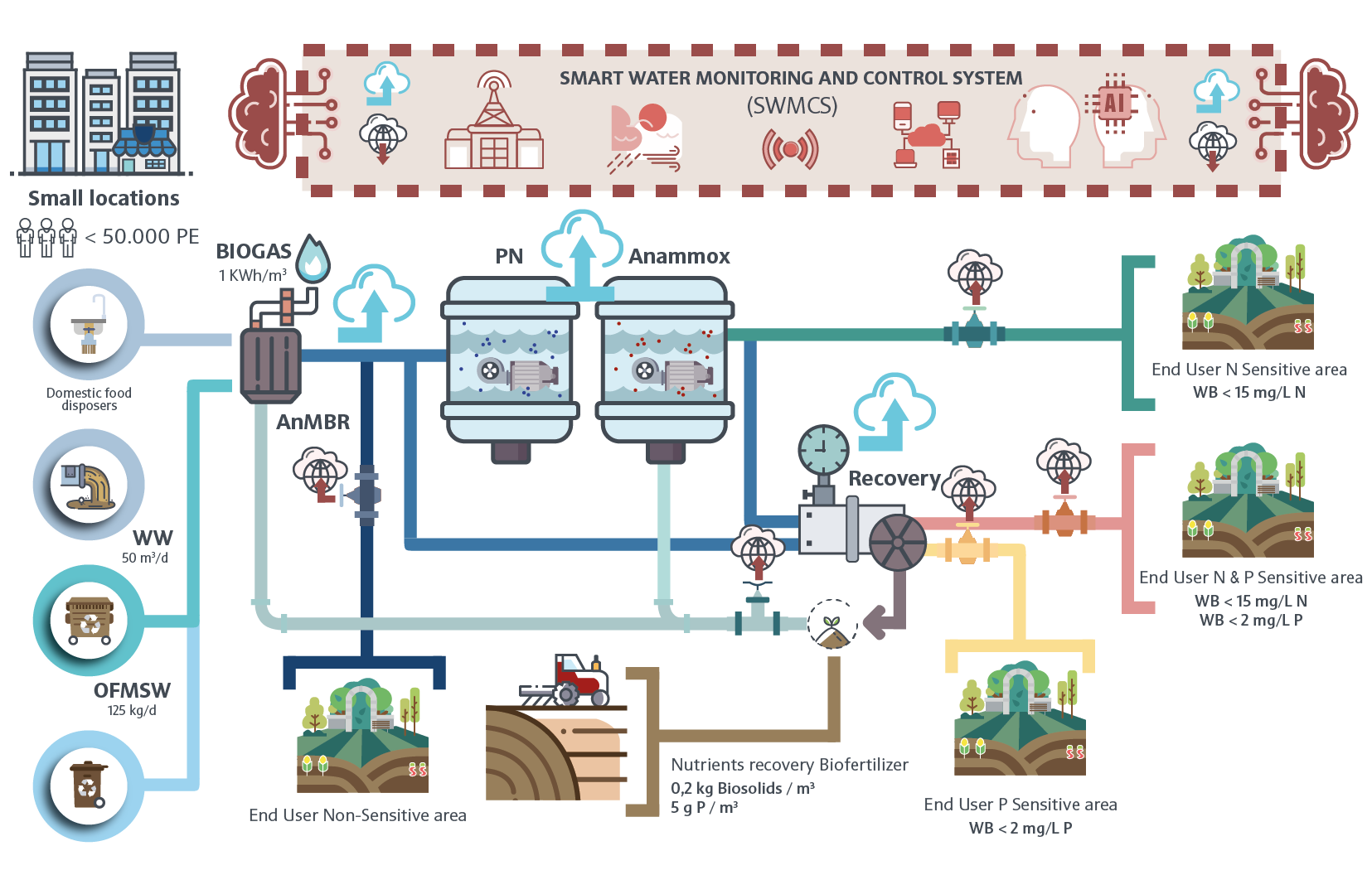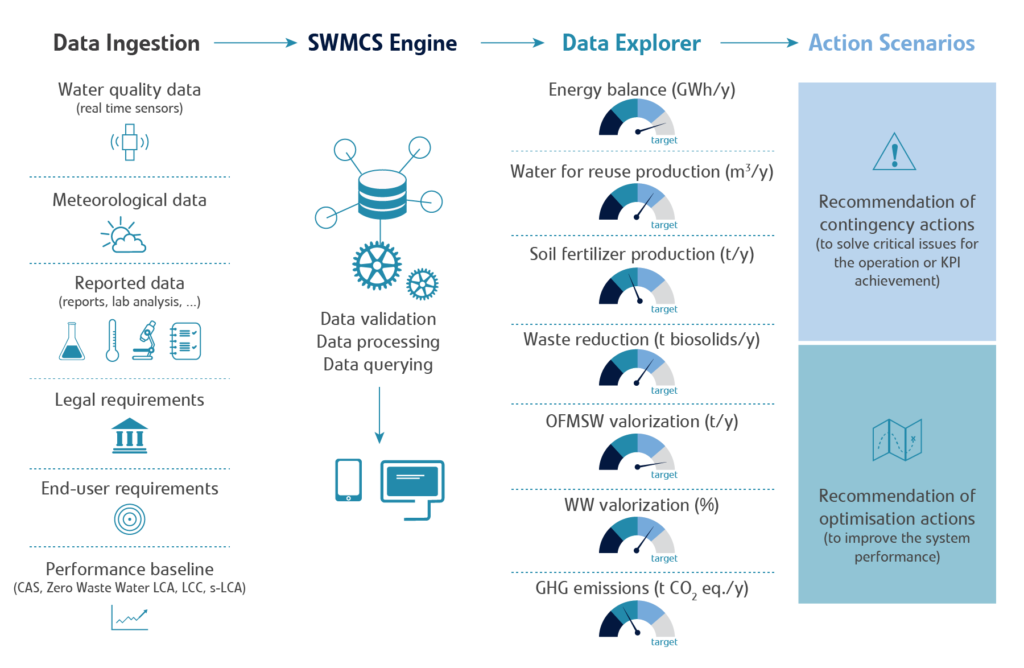Technology
TechnologyLIFE ZERO WASTE WATER (LZWW) is a Demonstration Project which will put into practice, test, and evaluate the applicability of an innovative, cost efficient and positive energy balance WWTP solution for the integrated management of mixed waste stream (OFMSW + WW) in the specific context of small locations (< 50.000 p. e.), based in the combination of technologies and methodologies independently validated at different scales (lab, demo, industrial scales) but never combined and applied in the project specific context, where current Sludge Anaerobic Digesters are not viable.
Main innovations will be; i) the combination of an Anaerobic Membrane Bioreactor (AnMBR) and Partial Nitritation-Anammox (PN/AMX) in a compact WWTP (not existing at industrial level and never been tested at demonstration scale) with synergic results suitable to be exploited in locations < 50.000 p. e. and ii) the development of a low carbon footprint strategy for the integrated management and treatment of mixed waste streams (OFMSW + WW) in Anaerobic WWTP.

Main innovations
The combination of an Anaerobic Membrane Bioreactor (AnMBR) and Partial Nitritation-Anammox (PN/AMX) in a compact WWTP
Bioreactora) Anaerobic Membrane Bioreactor (AnMBR)
The Anaerobic Membrane Bioreactor (AnMBR) integrates anaerobic treatment and membrane ultrafiltration within a single step, providing advantages compared to conventional aerobic solutions (High COD removal, methane production, low sludge yield). Biomethane is produced with a positive energy balance harvesting the energy contained in the organic matter.

AnMBR technology have been already been upscaled to full scale, but limited to industrial wastewater with high concentrations of COD and solids. However, has never been applied at industrial scale for municipal waste water treatments. UVEG and AQUALIA have a strong background in AnMBR technology and implemented LIFE MEMORY project, which demonstrated at industrial prototype scale (TRL7) the technical and economic feasibility of the AnMBR as a sustainable alternative to conventional urban WW treatment processes.
b) ANAMMOX Process (Anaerobic Ammonium Oxidation)
The ANAMMOX process (Anaerobic Ammonium Oxidation) is carried out by a group of autotrophic bacteria able to oxidize the ammonium to nitrogen gas without the need to supply oxygen (reducing the energy consumption) or organic matter. So, organic matter can be valorised in the AnMBR without compromising the final effluent quality in terms of total nitrogen concentration.

In the innovative LZWW WWTP solution, the effluent obtained in the AnMBR will be treated to remove nitrogen in a PN/AMX reactor [Aerobic Sequencing Batch Reactor (SBR) unit to perform the Partial Nitritation (PN) + an anoxic and SBR unit where the Anammox (AMX) process will take place]. In the PN/AMX system nitrogen is removed in the absence of organic matter, so, this technology is complementary to the AnMBR and will reduce the consumption of energy in 60 % (decreasing 2,67 kWh/kg N removed compared to CAS) and the production of sludge in almost 100 %. PN/AMX will enable the organic matter valorisation since it is not required for nitrogen removal (CAS requires organic content for heterotrophic denitrification) and will make anaerobic processes applicable in the specific context of < 50.000 p. e., overcoming the existing scale factor barriers.
PN/AMX was developed in JPI Waterworks PIONEER project by AQUALIA and USC where a PN/AMX reactor of 0,6 was operated delivering successful pilot-scale results (TRL5). An innovative strategy to operate the two-stage PN/AMX system was previously evaluated at both laboratory and pilot scales treating municipal WW at low temperature and the nitrification process was successfully achieved and maintained (Pedrouso et al.,2017).
c) Nutrient Recovery Module
It will be completed with a Nutrients Extraction & Recovery Module which will receive effluents from AnMBR and the PN/AMX and will produce recovered P and effluents to be used for agricultural or environmental purposes.
d) Smart Water Monitoring and Control System
A Smart Water Monitoring and Control System (SWMCS) will manage the operations and control the quality of the effluents in terms of microbiological content and concentration of P and N depending on the existing end-users demands and the irrigation and discharge regulations. The obtained effluent is expected to fit the EU standards as irrigation water in sensitive and non-sensitive areas. A fully automated measurement system performing rapid (15 min) microbiological on-line measurements will be integrated, producing real-time microbiological contamination measurements and ensuring the production of “Free-Pathogen” Water.

The water management system developed by AQUALIA in the H2020 project RUN4LIFE will be upgraded for developing the SWMCS. VWMS will integrate a water quality control tool based on ColiMinder® devices (to be adapted to the specific needs of this new application) for rapid microbiological on-line measurements which has never been introduced within an automated monitoring and control system.
Low carbon footprint strategy for the management of mixed streams (OFMSW + WW) in Anaerobic WWTP
Carbonfootprint
Strategy
Settings
A strategy will be developed for enhancing the supply of mixed waste streams with high organic load into the LZWW Anaerobic WWTP, while reducing the impact of the OFMSW management.
It will be based in the use of Food Waste Disposers (FWD) units, which are small macerators that are installed in the kitchen sink outlet of domestic households and restaurants. Most foods are reduced to small particles and pass via the kitchen drain to the public sewer network. FWD has the potential to eliminate the KFW fraction from the MSW preventing most of the separate OFMSW collection problems, whilst providing a number of additional benefits:
The higher organic load of the mixture KFW + WW contribute to higher biogas yields increasing the performance of the Anaerobic WWTP.
Terrestrial transportation of KFW can be avoided, reducing CO2 emissions balance related to OFMSW handling versus the OFMSW centralized collection and composting.
The strategy will consider several scenarios, including the combination and synergies with pre-existing systems of separate OFMSW collection at municipal level and/or HoReCa establishments with sorting KFW at source where the OFMSW could be directly disposed in the Anaerobic WWTP, treated and properly mixed with WW, thus avoiding the transport to centralized MSW plants usually located far from cities of such size. This will increase the application of the strategy as this could be customized to the characteristics of each particular < 50.000 p. e. location.
FWD have been used for more than 80 years now in the US, where their usage evolved to reach more than 94 % of all cities (Marashlian and El-Fadel, 2005). The total number of FWD in active use has been estimated at 45 million by In-Sink-Erator.
Concerns about increased energy consumption and sludge generation in WWTP, as a result of the increased organic load, when wastewater is treated AEROBICALLY, have limited their use in Europe and questioned their use in the USA. Indeed, in UK and Holland, scarcely 5 percent of the households have FWD (Karlberg and Norin, 1999), while in other EU regions their use is not allowed.
The use of FWD in locations < 50.000 p. e. combined with the WWTP ANAEROBIC solution developed by LZWW will overcome the restrictions established for the Aerobic systems and, with proper awareness, regulations update and adaptations to specific scenarios, will increase the adoption of this sustainable waste management strategy.



